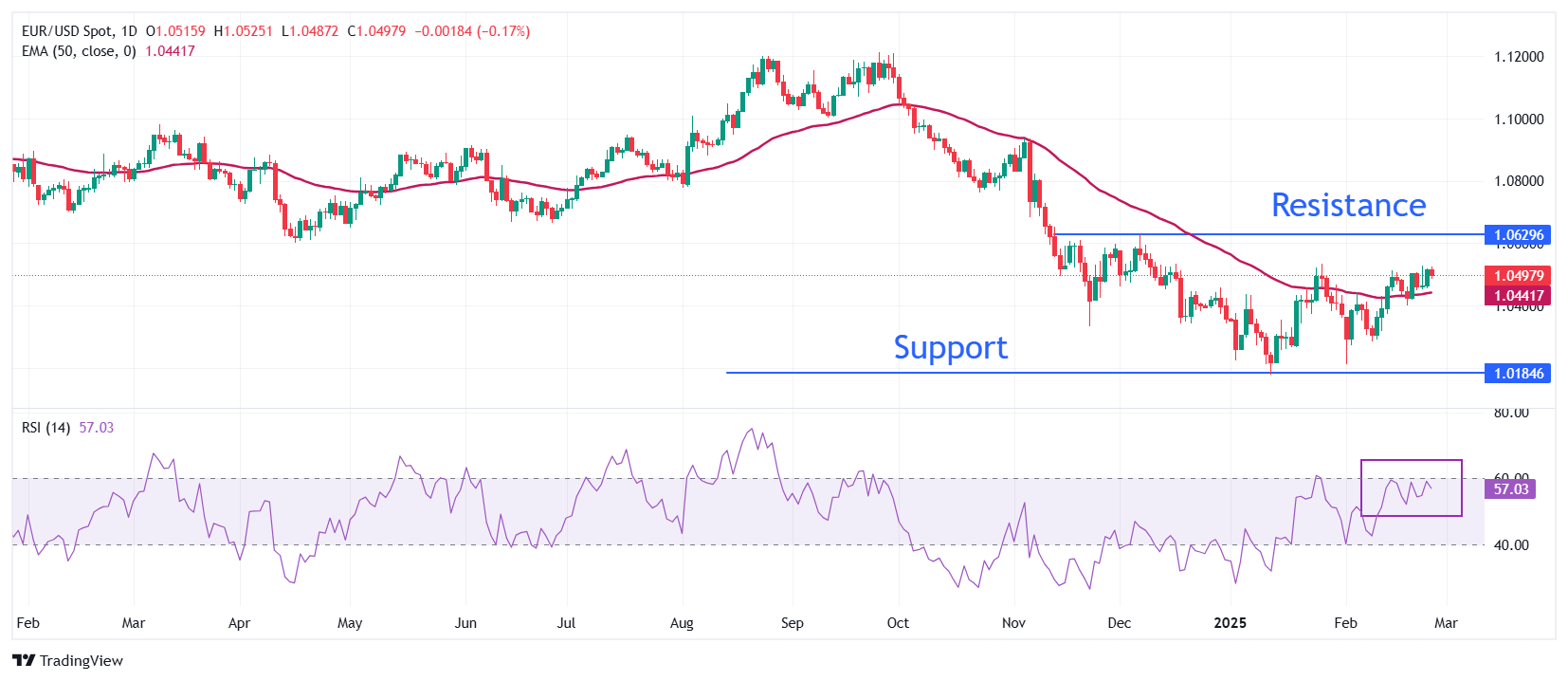EUR/USD declines as US House of Representatives passes Trump’s tax cut plan
- EUR/USD retraces below 1.0500 on Wednesday as the US Dollar gains amid a strong recovery in US bond yields.
- Republicans-controlled House of Representatives passed a $4.5 trillion tax cut plan on Tuesday.
- Investors await the preliminary German HICP for February and the US PCE inflation data for January, scheduled for Friday.
EUR/USD continues to face selling pressure above the psychological level of 1.0500 in Wednesday’s European session. The major currency pair falls due to a strong recovery in the US Dollar (USD). The US Dollar Index (DXY), which tracks the Greenback’s value against six major currencies, recovers sharply to near 106.50 after a weak opening around the 11-week low of 106.10 earlier in the day.
The Greenback capitalizes on a strong recovery in US bond yields, which had been sliding for almost a month. The 10-year US Treasury yields jump to near 4.33% after posting a fresh 13-week low at around 4.28% earlier in the day.
A green light to United States (US) President Donald Trump’s $4.5 trillion tax cut plan by the House of Representatives forced traders to dump government bonds, assuming that lower taxes on individuals would accelerate their purchasing power. Such a scenario would prompt inflationary pressures and force the Federal Reserve (Fed) to keep interest rates in the current range of 4.25%-4.50% for longer.
For fresh cues on the current status of inflation, investors await the US Personal Consumption Expenditures Price Index (PCE) data for January, which will be released on Friday. The core PCE inflation data – the Fed’s preferred inflation gauge as it excludes volatile food and energy items – is estimated to have decelerated to 2.6% year-over-year from 2.8% in December. Soft underlying inflation data would weigh on market expectations that the Fed will remain in the “waiting” mode for longer.
Daily digest market movers: EUR/USD drops amid recovery in US Dollar
- EUR/USD is down as investors have underpinned the US Dollar against the Euro (EUR). Meanwhile, the shared currency outperforms other peers as investors shift focus to the European Central Bank’s (ECB) policy meeting, which will be held next week.
- The ECB is almost certain to cut the Deposit Facility rate by 25 basis points (bps) to 2.5%. Therefore, investors will pay close attention to the ECB’s monetary policy guidance. A slew of ECB officials has been guiding that the central bank should continue reducing interest rates based on expectations that inflation will sustainably return to the 2% target.
- Soft Eurozone Q4 Negotiated Wage Rate data, a key measure of wage growth, has also boosted ECB dovish bets. On Tuesday, the ECB reported that the wage growth measure rose at a slower pace of 4.12% compared to the 5.43% increase seen in the third quarter of the previous year.
- However, ECB board member Isabel Schnabel seems to criticize dovish bets as she believes that Eurozone's economic weakness is “not due to overly high borrowing costs” but to “structural factors”. Her commentary indicated that she doesn’t support further policy easing. “It's no longer clear the current 2.75% rate is still holding back the eurozone economy,” Schnabel said.
- Going forward, investors will focus on the German flash Harmonized Index of Consumer Prices (HICP) data for February, which will be published on Friday.
Technical Analysis: EUR/USD wobbles around 1.0500

EUR/USD stays in a tight range at around 1.0500 on Wednesday. The 50-day Exponential Moving Average (EMA) continues to support the major currency pair around 1.0440.
The 14-day Relative Strength Index (RSI) wobbles just below 60.00. A bullish momentum would activate if the RSI (14) manages to sustain above that level.
Looking down, the February 10 low of 1.0285 will act as the major support zone for the pair. Conversely, the December 6 high of 1.0630 will be the key barrier for the Euro bulls.
Euro FAQs
The Euro is the currency for the 19 European Union countries that belong to the Eurozone. It is the second most heavily traded currency in the world behind the US Dollar. In 2022, it accounted for 31% of all foreign exchange transactions, with an average daily turnover of over $2.2 trillion a day. EUR/USD is the most heavily traded currency pair in the world, accounting for an estimated 30% off all transactions, followed by EUR/JPY (4%), EUR/GBP (3%) and EUR/AUD (2%).
The European Central Bank (ECB) in Frankfurt, Germany, is the reserve bank for the Eurozone. The ECB sets interest rates and manages monetary policy. The ECB’s primary mandate is to maintain price stability, which means either controlling inflation or stimulating growth. Its primary tool is the raising or lowering of interest rates. Relatively high interest rates – or the expectation of higher rates – will usually benefit the Euro and vice versa. The ECB Governing Council makes monetary policy decisions at meetings held eight times a year. Decisions are made by heads of the Eurozone national banks and six permanent members, including the President of the ECB, Christine Lagarde.
Eurozone inflation data, measured by the Harmonized Index of Consumer Prices (HICP), is an important econometric for the Euro. If inflation rises more than expected, especially if above the ECB’s 2% target, it obliges the ECB to raise interest rates to bring it back under control. Relatively high interest rates compared to its counterparts will usually benefit the Euro, as it makes the region more attractive as a place for global investors to park their money.
Data releases gauge the health of the economy and can impact on the Euro. Indicators such as GDP, Manufacturing and Services PMIs, employment, and consumer sentiment surveys can all influence the direction of the single currency. A strong economy is good for the Euro. Not only does it attract more foreign investment but it may encourage the ECB to put up interest rates, which will directly strengthen the Euro. Otherwise, if economic data is weak, the Euro is likely to fall. Economic data for the four largest economies in the euro area (Germany, France, Italy and Spain) are especially significant, as they account for 75% of the Eurozone’s economy.
Another significant data release for the Euro is the Trade Balance. This indicator measures the difference between what a country earns from its exports and what it spends on imports over a given period. If a country produces highly sought after exports then its currency will gain in value purely from the extra demand created from foreign buyers seeking to purchase these goods. Therefore, a positive net Trade Balance strengthens a currency and vice versa for a negative balance.

